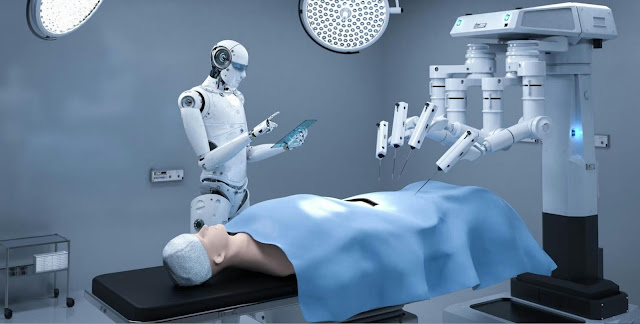Robotic Process Automation In Healthcare Sector: Bringing Efficiency And Improving Patient Outcomes
 |
| Robotic Process Automation In Healthcare |
Robotic process automation (RPA) refers to the use of software with artificial intelligence and machine learning capabilities to handle high-volume, repeatable tasks that previously required human performers. RPA automates routine workflows and activities across clinical and business operations in a healthcare organization. By deploying RPA, healthcare providers can streamline clinical and administrative processes to optimize costs and enhance the quality of patient care delivery.
Robotic Process Automation in Healthcare ffers immense potential for reducing clinical costs for healthcare providers by improving operational efficiency and optimizing resource utilization. One of the key areas where RPA brings substantial cost savings is clinical documentation. The repetitive tasks associated with clinical documentation such as retrieving patient information from different clinical records systems, populating forms and templates, and updating records can be automated through RPA bots. This reduces the time spent by clinicians and medical coders on manual documentation tasks. For example, studies show RPA-based clinical documentation solutions can potentially save healthcare organizations upwards of $9000 per provider annually in documentation costs.
Robotic process automation in healthcare also optimizes costs associated with
clinical department workflows like lab, radiology and pharmacy. Robotic bots
can automatically retrieve lab test results from lab systems, match results to
correct patient records and populate electronic health records (EHR).
Similarly, RPA streamlines workflows in radiology by capturing imaging results,
routing to appropriate specialists and updating diagnostic reports. In pharmacy
as well, robotic assistants perform high-volume picking, packing and delivery
tasks more efficiently reducing turnaround times and labor costs. Overall,
automating routine clinical workflows helps free up clinicians' time so they
can focus more on direct patient care activities.
Enhancing Patient Safety through
Regulatory Compliance
Ensuring complete compliance with regulatory standards is critical in
healthcare to maintain patient safety and data privacy. However, keeping track
of various compliance requirements spread across clinical, operational and
reporting workflows presents an ongoing challenge. Here, RPA plays a vital role
in promoting regulatory compliance through continuous monitoring capabilities.
Robotic systems can be programmed to watch out for compliance-related
exceptions and alert staff in real-time. They also reduce the risks of
non-compliance due to human errors by automating tedious compliance-driven
tasks.
For example, bots regularly screen patient records for missing or incomplete
data as per documentation protocols. They identify gaps, initiate work items to
complete missing information and ensure timely sign-offs. Similarly, RPA aids
HIPAA compliance by monitoring access to protected health information and
alerting authorities in cases of unauthorized access attempts. Overall, such regulatory
oversight functions automated through RPA go a long way in safeguarding patient
safety, data privacy and maintaining compliance standards.
Transforming Population Health
Management
Proactive population health management focusing on preventive care delivery and
chronic condition management has become increasingly crucial for value-based
care. However, manual resources limit the scale and scope of evidence-based
interventions at the community level. Here RPA can play a transformative role
by aggregating and analysing patient profile data from multiple sources.
AI-powered bots then derive meaningful insights on at-risk populations, care
gaps, social determinants and intervention effectiveness.
Armed with these inputs, healthcare organizations can conduct hyperpersonalized
outreach campaigns to address issues such as medication non-adherence and
missed appointments. RPA also supports automation of routine population health
workflows like reminder generation, appointment booking and surveys. Over time,
as these interventions prove impactful in optimizing health outcomes, RPA helps
drive down costs of chronic care at the community level through improved
prevention and early detection efforts. This transforms population health
management from being a resource-intensive process to an efficient, scalable
solution.
Reducing Back-office Workloads through
Automation
Apart from clinical functions, RPA brings significant benefits in healthcare
back-office domains like claims management, revenue cycle operations, supply
chain and human resources as well. The repetitive manual tasks involved in
these departments ranging from data entry, transaction processing to record
keeping can be automated to streamline workflows. For example, robotic systems
can extract data from insurance claim forms, populate appropriate fields in
billing software and route claims for payment follow-ups.
Similarly, in revenue cycle management, bots verify patient insurance
eligibility, fetch authorization and handle prior authorization requests to
expedite claim reimbursements. Moreover, RPA assists inventory management and
supply ordering by automating replenishment calculations based on usage trends.
In HR operations, robotics eliminates mundane tasks like onboarding paperwork,
timesheet processing and payroll updates. By automating such routine
back-office functions, RPA relieves staff to focus on more strategic,
knowledge-based responsibilities improving both workforce productivity and
satisfaction.
Leveraging RPA for Improved Patient Experiences
RPA serves as an instrumental lever for enhancing patient engagement and
streamlining care experiences across departments. Bots facilitate seamless
self-service options for patients to access their health records, laboratory
test results and schedule/cancel appointments online. Automated verification of
insurance and financial clearance on registration removes hurdles in obtaining
timely care access. RPA also powers AI chatbots to triage patients with queries
and direct them to appropriate care resources.
By enabling functions like prescription refill reminders, post-discharge care
plans and vaccination alerts, RPA fosters proactive healthcare. Centralized
command of all patient touchpoints through the care journey helps predict and
address dissatisfiers to make experiences smoother. Overall, automation
amplifies the scale and scope of patient-centric initiatives to strengthen
loyalty, adherence and clinical outcomes in the long run.
Robotic process automation in healthcare presents a collaborative, non-invasive solution for healthcare organizations to streamline clinical and business processes. By automating repetitive, rule-based tasks across departments, RPA optimizes resource utilization, promotes operational efficiency, regulatory compliance and transformed experiences. Integrating RPA with existing clinical and EHR systems carries minimal disruption risks. As the technology continues advancing, RPA will likely become an indispensable healthcare operations lever for improved costs, quality and patient outcomes over the next decade.
Get more insights, On Robotic Process Automation in Healthcare
Explore More Related Topic on, Robotic
Process Automation in Healthcare



Comments
Post a Comment